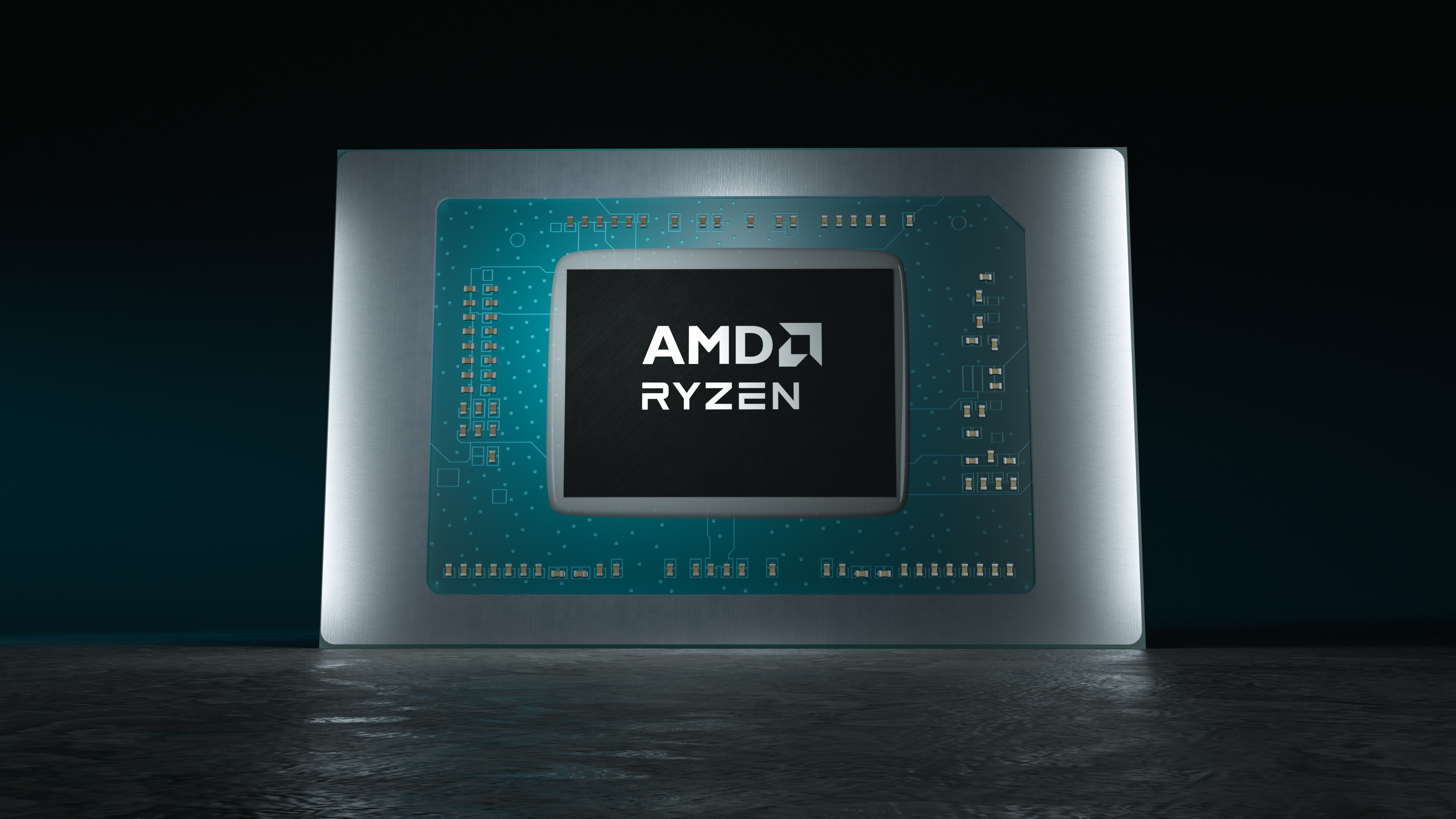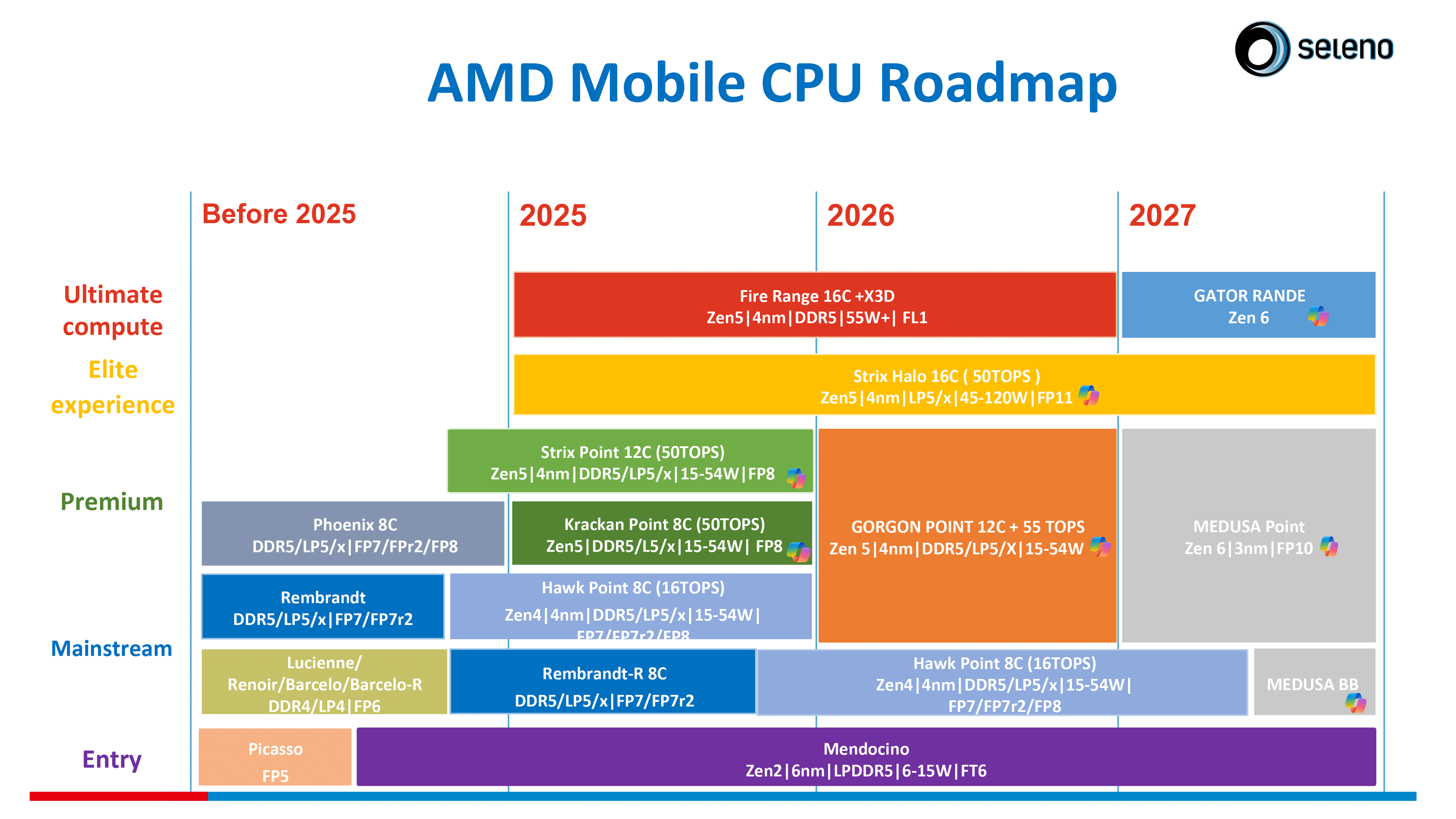AMD mobile CPU roadmap leak claims Zen 6 arrives in 2027
As Zen 6 arrives to high-end, Zen 2 dominates low-end laptops.

A Spain-based laptop maker has inadvertently leaked (via @x86deadandback) what seems to be AMD's Mobile CPU roadmap for the next two years. The roadmap spans from 2024 to 2027 and covers processors based on the Zen 4, Zen 5, and Zen 6 microarchitectures, but it isn't an official roadmap from AMD.
According to the roadmap, while AMD will continue to be aggressive in the laptop market to gain market share from Intel, it looks like going forward, it will consolidate its product families to offer a more consistent user experience across different segments. Keep in mind that since the roadmap comes from an unofficial source, it may contain inaccuracies.
High-end ang gaming segments
The ultimate gaming notebooks today use AMD's Ryzen 9 9955HX3D, 9955HX, or 9850HX 'Fire Range' processors with up to 16 Zen 5 cores. These CPUs — which are essentially AMD's Ryzen 9000-series 'Granite Ridge' processors in a BGA package for laptops — will continue to serve its market segments till 2027, when it is expected be replaced by AMD's codenamed Ryzen 'Gator Range' processors based on the Zen 6 microarchitecture and featuring an NPU with performance of over 40 TOPS and thus supporting all Copilot+ features.
It is unclear whether these Gator Range CPUs will also pack Zen 6 core complex dies (CCDs) and an IO die (IOD) originally intended for desktops to serve elite gaming notebooks, but this is certainly one of the possibilities.
Interestingly, but for now, AMD's roadmap does not list any replacements for its Strix Halo processors that have the ultimate built-in GPU, and the slide indicates that these parts will be available till at least the end of 2027.
Premium and mainstream segments
Speaking of Zen 6, AMD is allegedly prepping Medusa Point processors based on the Zen 6 microarchitecture and made on a 3nm-class fabrication technology in an FP10 packaging for premium laptops in 2027 as well as Medusa BB (Medusa Baby) CPUs for mainstream notebooks in the second half of 2027 (keep in mind that the slide does not specifically attributes Zen 6 or 3nm to Medusa Baby).
The roadmap does not disclose the core count of these products, though given the fact that they are made on a 3nm-class fabrication node and rather aggressive core count increase by competing processors from Intel, it is reasonable to expect Medusa Point and Medusa Baby to gain the number of cores compared to the chips that they replace.
But before Zen 6-based Medusa Point and Medusa Baby arrive in 2027, AMD is said to introduce its codenamed Gorgon Point processor that will replace Ryzen AI 300-series 'Strix Point' and 'Krackan Point' as well as Ryzen 8000-series 'Hawk Point' in the premium segment in 2026. As a result, AMD will offer Zen 5 across all of its premium offerings in 2026. Meanwhile, Copilot+-capable NPU will be inside all of AMD's processors (except low-end Ryzen 7020-series) in 2027.
Get Tom's Hardware's best news and in-depth reviews, straight to your inbox.
The Gorgon Point will feature up to twelve Zen 5 cores and a new NPU with up to 55 TOPS performance. The unit will be made on a 4nm-class manufacturing technology (so AMD could save on design implementation and photomasks) and will span from a 15W to a 54W configurable TDP, thus serving multiple notebook classes.
One interesting thing to note is that while Gorgon Point clearly replaces Zen 5-powered Strix Point and Krackan Point in AMD's roadmap, it pushes Zen 4-based Hawk Point 8C to the lower-end mainstream segment, where it is set to serve till the second half of 2027 when it will be replaced by Medusa Baby.
Zen 2 for the entry level
As for entry-level machines, AMD will continue offering its Ryzen 7020-series 'Mendocino' processors with up to four Zen cores and RDNA 2 graphics for this segment for years to come. Apparently, the company believes that these CPUs are competitive enough with products like Intel's Twin Lake-N, so it does not make a lot of sense to replace them.
Follow Tom's Hardware on Google News to get our up-to-date news, analysis, and reviews in your feeds. Make sure to click the Follow button.

Anton Shilov is a contributing writer at Tom’s Hardware. Over the past couple of decades, he has covered everything from CPUs and GPUs to supercomputers and from modern process technologies and latest fab tools to high-tech industry trends.
-
usertests ReplyAMD's codenamed Ryzen 'Gator Range' processors based on the Zen 6 microarchitecture and featuring an NPU with performance of over 40 TOPS and thus supporting all Copilot+ features.
This might be the biggest news. Since the Range chips are repackaged desktop chips, this seems to confirm that Olympic Ridge desktop CPUs will include an XDNA2 or newer NPU.
Interestingly, but for now, AMD's roadmap does not list any replacements for its Strix Halo processors that have the ultimate built-in GPU, and the slide indicates that these parts will be available till at least the end of 2027.
Some have said that Medusa Halo is cancelled, others say that it's delayed. Strix Halo gets the job done for AI, while gaming performance is comparable to RTX 4060M/5060M/4070M. So today's $800-1200 laptops with those chips will get cheaper throughout 2026-2027, and an eventually RTX 6060M will bury it.
The Gorgon Point will feature up to twelve Zen 5 cores and a new NPU with up to 55 TOPS performance. The unit will be made on a 4nm-class manufacturing technology (so AMD could save on design implementation and photomasks) and will span from a 15W to a 54W configurable TDP, thus serving multiple notebook classes.
It's Strix Point refresh, bro.
Apparently, the company believes that these CPUs are competitive enough with products like Intel's Twin Lake-N, so it does not make a lot of sense to replace them.
The Mendocino prices are too high. -
Notton I think there is no Medusa Halo because it has been superseded by the Magnus/Orion/Canis bridged chiplet SoC.Reply
It's been rumored Valve is looking at Magnus too, although unlikely to be that powerful.
On the positive side, that means Zen6+RDNA5.
On the negative side, that means we don't get to see a new super APU until at least 2028. -
pug_s Reply
I wonder how much are the 7320u and 7520u soc's compared to the Intel N100/150?usertests said:The Mendocino prices are too high. -
DS426 Reply
Intel has to purchase the RAM because it's on the CPU package -- AMD doesn't as Strix Point and S Halo have the RAM off-chip. This means mobo manufacturers purchase and solder it, which is more economical. Not saying it's cheap but probably cheaper. That or we can say that AMD doesn't take the margin hit while motherboard makers do instead, which I also doubt as OEM's tend to have high markups on systems with relatively more RAM in comparison to purchasing RAM on a retail or wholesale marketplace and installing it oneself.baboma said:...
As well, those 128GB LPDDR5 8000 soldered RAM aren't cheap, and will impact gross margins, as Intel has divulged for Lunar Lake and its 32GB soldered RAM. Strix Halo's high pricing means only serious AI enthusiasts will look at it, but that demographic would want accommodations for a dGPU (not eGPU).
...
Serious AI enthusiasts are going to utilize a dGPU typically, yes. This doesn't mean Strix Halo doesn't make for some decent "AI boxes", even with a dGPU. Not saying I'm one, but for some anecdote, I'm averaging about 14 tokens/second on a HX 375 ("regular" Strix Point) with 32 GB of RAM with the openai/gpt-oss-20b model in thinking mode in LM Studio. There's a lot of RAM left on the table since it's quantized with MXFP4. Still, doesn't seem bad for a system without a dGPU, even if it isn't the sexiest model in the world either. -
usertests Reply
Maybe, but never confirmed that Zen 6 desktop CPUs would get an NPU. It was only in 8000G desktop APUs, not present in 7000/9000 CPUs at all. It could be missing in some models if AMD uses two different I/O dies.baboma said:Desktop-class CPUs getting updated NPU is expected.
Though the real fun of Olympic Ridge I/O will be things like the iGPU and the memory controller.
Intel's problem was expenses related to memory-on-package, which Strix Halo doesn't use. Source:baboma said:As well, those 128GB LPDDR5 8000 soldered RAM aren't cheap, and will impact gross margins, as Intel has divulged for Lunar Lake and its 32GB soldered RAM. Strix Halo's high pricing means only serious AI enthusiasts will look at it, but that demographic would want accommodations for a dGPU (not eGPU).
However, on-package memory means that Intel needed to procure these LPDDR5X devices at prices higher than those available to large OEMs. This, for obvious reasons, affects Intel's own profit margin. Handling that memory and installing it on the package also costs money, another factor that affects the profitability of the Lunar Lake product. Finally, selling CPUs with pre-installed memory reduces flexibility for PC makers, which is important for them.
I think Strix Halo pricing is what they can get away with charging, not related to real costs for 64-128 GB LPDDR5X.
LPDDR5X/LPDDR6 in general should be cheaper per gigabyte than GDDR7, HBM, etc. It's going to keep reappearing in AI products, and perhaps in low-end graphics cards if MLID's recent leak is to be believed.
I see the 7520U laptops in the $250-350 range, and i3-N300 around $200-300. But Intel has made Alder Lake-N in such volume that the quad-cores show up in $100-150 mini PCs, where Mendocino has no presence at all. I don't see much of dual-core Mendocino either (e.g. Athlon Gold 7220U), not that we'd want to.pug_s said:I wonder how much are the 7320u and 7520u soc's compared to the Intel N100/150? -
DS426 An unofficial roadmap leak? So practically zero credibility? A leak is one thing, and official documents are at least something to go by, even though plans, schedules, and specs change prior to a product's official announcement and market release.Reply
I can't imagine AMD allowing Panther Lake and Nova Lake being on the market for that long without fresh competition. -
Mr Majestyk Reply
Well with Zen 6 desktop not available to H2 2026, I don't see apu's coming out say 6 months later as unbelievable. They will have Gorgon Point to fight against Arrow Lake H and Panther Lake H in 2026.DS426 said:An unofficial roadmap leak? So practically zero credibility? A leak is one thing, and official documents are at least something to go by, even though plans, schedules, and specs change prior to a product's official announcement and market release.
I can't imagine AMD allowing Panther Lake and Nova Lake being on the market for that long without fresh competition.
Still I've been underwhelmed by Strix Point and look forward to seeing if Intel can deliver a truly good apu with Panther Lake. It will easily beat out Strix Point in iGPU and be way more efficient. Top tier Panther with 4+8+4+12Xe3 @ 25W sounds like it could be very nice and will have > 100TOPS. -
pug_s Reply
AMD seems to be sitting in its laurels with its not so great Ryzen 9000 launch which cpu's seems to be optimized for the enterprise. Instead they seem to stress about Strix Halo instead as an answer to Nvidia's AI products with mixed results.usertests said:Maybe, but never confirmed that Zen 6 desktop CPUs would get an NPU. It was only in 8000G desktop APUs, not present in 7000/9000 CPUs at all. It could be missing in some models if AMD uses two different I/O dies.
Though the real fun of Olympic Ridge I/O will be things like the iGPU and the memory controller.
Intel's problem was expenses related to memory-on-package, which Strix Halo doesn't use. Source:
I think Strix Halo pricing is what they can get away with charging, not related to real costs for 64-128 GB LPDDR5X.
LPDDR5X/LPDDR6 in general should be cheaper per gigabyte than GDDR7, HBM, etc. It's going to keep reappearing in AI products, and perhaps in low-end graphics cards if MLID's recent leak is to be believed.
I see the 7520U laptops in the $250-350 range, and i3-N300 around $200-300. But Intel has made Alder Lake-N in such volume that the quad-cores show up in $100-150 mini PCs, where Mendocino has no presence at all. I don't see much of dual-core Mendocino either (e.g. Athlon Gold 7220U), not that we'd want to.
With Intel being in such a mess right now, one of the things it shines is their inexpensive Alter lake N cpu's, and AMD don't even want to compete with Intel in. That and many companies are upgrading their corporate desktops which usually have mid range Intel CPU's in it anyways. -
usertests Reply
People like Zen 5 X3D in client. But yeah, Zen 5 was great for AVX-512 and some other workloads, less so for the consumer/gamer. It's going to be uninteresting in comparison to Zen 6, which will increase the L3 cache everywhere and shake up their segmentation for the first time in several years (potentially with 10-core being the lowest end, or 8-core if not).pug_s said:AMD seems to be sitting in its laurels with its not so great Ryzen 9000 launch which cpu's seems to be optimized for the enterprise. Instead they seem to stress about Strix Halo instead as an answer to Nvidia's AI products with mixed results.
Strix Halo is quite good, but it's limited in scope by pricing and design wins I guess.
And those corporate desktops will shine in the refurbished market years later. Arrow Lake is actually good when TDP limited and you are forced to use the iGPU (which at the full 4 Xe cores is about twice as fast as the Raptor Lake and Ryzen 7000/9000).pug_s said:With Intel being in such a mess right now, one of the things it shines is their inexpensive Alter lake N cpu's, and AMD don't even want to compete with Intel in. That and many companies are upgrading their corporate desktops which usually have mid range Intel CPU's in it anyways.
In the Intel version of this leaked roadmap, Wildcat Lake is being positioned at a higher tier than Alder Lake-N (which only dipped into premium territory with its "Core i3-N3xx"). It's arguably the replacement, but it won't be possible to make them as cheaply on Intel 18A.
